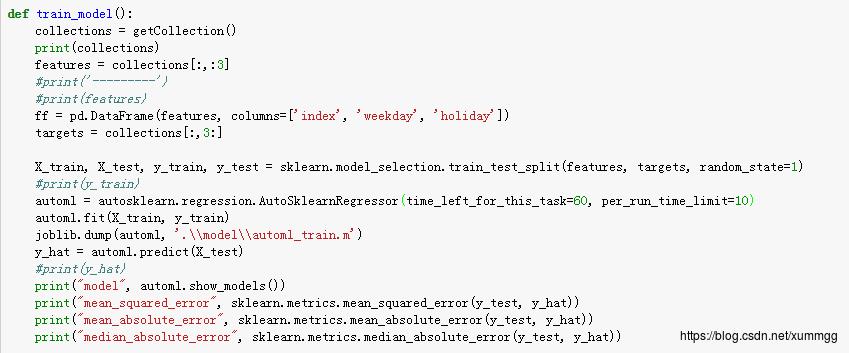Ubuntu14下Auto-sklearn安装调试总结
Posted XianMing的博客
tags:
篇首语:本文由小常识网(cha138.com)小编为大家整理,主要介绍了Ubuntu14下Auto-sklearn安装调试总结相关的知识,希望对你有一定的参考价值。
1. 说明
本次调试目的:因为公司内部需要做一个算法比较,顺带学习使用该技能,因为太久没有更新博客,本次调试运用为主,原理之后空了再深究
2. 原理篇
2.1什么是auto-sklearn

图1 :Auto-sklearn框架结构(图摘自2015年的论文,此时只支持分类,现在的版本添加了回归)
Auto-sklearn是一个自动化机器学习框架,结构如图1所示,用户只要输入数据和标签,框架可以自动进行数据预处理,特征预处理,(分类/回归)算法选择,最终可导出模型,存储并使用。
auto-sklearn在KDnuggets举办的机器学习博客大赛中,取得了冠军。另外的热门自动机器学习框架auto_ml和TPOT。
2.2 简单的原理介绍
Auto-sklearn可以通过贝叶斯优化方式将超参数最优化,就是通过不断迭代以下几个步骤:
1).创建一个概率模型,来找到超参数设置与机器学习的表现之间的关系
2).使用这个模型来挑选出有用的超参数设置,通过权衡探索与开发,进而继续尝试。探索指的是探索模型的未知领域;开发指的是重点从已知的空间中找到表现良好的部分。
3).设置好超参数,然后运行机器学习算法。
下面将进一步阐明这个过程是如何进行的:
这个过程可以概括为联合选择算法、预处理方法以及超参数。具体如下:分类/回归的选择、预处理方法是最高优先级、分类超参数、被选择方法的超参数会被激活。我们将使用贝叶斯优化方法来搜索组合空间。贝叶斯优化方法适用于处理高维条件空间。我们使用SMAC,SMAC是的基础是随机森林,它是解决这类问题的最好方式。
就实用性而言,由于Auto-sklearn直接替代scikit-learn的estimator,因此scikt-learn需要安装这个功能,我们才能利用到这个优势。Auto-sklearn同样也支持在分布式文件系统中进行并行计算,同时它也可以利用scikit-learn模型的持续特性。
参考:
https://www.leiphone.com/news/201701/dKfVIWiDaWvdMqKu.html?winzoom=1&viewType=weixin
https://papers.nips.cc/paper/5872-efficient-and-robust-automated-machine-learning.pdf
3. 安装篇
3.1 系统需求
• Linux operating system (for example Ubuntu),
• Python (>=3.5).
• C++ compiler (with C++11 supports) and SWIG (version 3.0 or later)
3.2 安装过程
本测试采用ubuntu14.04系统,其中gcc version=4.8.4
3.2.1 python3.5版本升级
由于ubuntu14的python为2.7版本,根据3.1系统需求需要升级到python3.5以上
添加 PPA:
sudo add-apt-repository ppa:fkrull/deadsnakes
sudo apt-get update安装 Python 3
sudo apt-get install python3.5
sudo apt-get install python3.5-dev
sudo apt-get install libncurses5-dev取消原本的 Python 3.4 ,并将 Python3 链接到最新的 3.5 上:
sudo mv /usr/bin/python3 /usr/bin/python3-old
sudo ln -s /usr/bin/python3.5 /usr/bin/python3安装新版pip:
wget https://bootstrap.pypa.io/get-pip.py
sudo python3 get-pip.py
sudo pip3 install setuptools --upgrade
sudo pip3 install ipython[all]取消原本的 Python 2.7 ,并将 Python 链接到最新的 3.5 上:
sudo mv /usr/bin/python /usr/bin/python-old
sudo ln -s /usr/bin/python3.5 /usr/bin/python参考:
https://www.jianshu.com/p/4f4b2ed568f4
3.2.2 安装swig3
如果按照官方要求安装sudo apt-get install build-essential swig,默认安装的是的swig2,后续安装pyrfr会报错Can not install pyrfr , error: command ‘swig’ failed with exit ,参考https://github.com/automl/auto-sklearn/issues/314 的错误回答,安装swig3:
Sudo apt-get install swig3
sudo ln -s /usr/bin/swig3.0 /usr/bin/ swig第一句是按照swig3,第二句是添加swig的软链接。
3.2.3 安装auto-sklearn
安装auto-sklearn的所有依赖包:
curl https://raw.githubusercontent.com/automl/auto-sklearn/master/requirements.txt | xargs -n 1 -L 1 sudo pip install安装auto-sklearn:
Sudo pip install auto-sklearn注意:安装完成后,在使用fit进行训练会报Error when using “rf_with_instances.py,此处需要修改SMAC3内rf_with_instances.py的源码。参考:
https://github.com/automl/SMAC3/issues/298
操作方法如下:
cd /usr/local/lib/python3.5/dist-packages/smac/epm
sudo vim rf_with_instances.py把下面的
self.rf.fit(data, rng=self.rng)修改成
self.rf.fit(data, self.rng)4. 调试篇
Auto-sklearn现在仅支持监督学习的分类和回归(官网说明未来希望支持深度学习等内容)。
本次也做两个实验,一个是auto-sklearn分类算法的应用,手写数字识别,见4.1。另一个是auto-sklearn回归算法的应用,iptv用户数预测(仅预测10分钟),见4.2。
4.1 手写数字识别(分类问题)
在ipython中运行如下代码(官方用例),对手写数字识别进行训练(分类问题)。准确率达到99.3%。运行本用例程序需要1小时。

如果需要减少运行时间,需要添加参数:time_left_for_this_task和per_run_time_limit。time_left_for_this_task表示该任务一共跑多少时间(秒),默认是3600,所以会跑1小时;per_run_time_limit表示每种算法跑多少时间(秒);参考代码如下: time_left_for_this_task设置成60秒,per_run_time_limit设置为10秒

API默认的内存使用为3G,可以自行配置,详见API:http://automl.github.io/auto-sklearn/stable/api.html
官方建议实际应用中auto-sklearn跑24小时或越久越好。
另外,auto-sklearn的存储方式与sklearn相同,4.2中也将使用:
from sklearn.externals import joblib
…………
automl.fit(X_train, y_train)
joblib.dump(automl, '.\\\\model\\\\automl_train.m')
…………
automl_new = joblib.load('.\\\\model\\\\automl_train.m')4.2 iptv用户数预测(回归问题)
4.1中为官方用例的简单试用,本用例为iptv用户预测(回归问题):从10.10.1.209的mysql数据库中获取数据(公司内部的生产数据),并使用auto-sklearn进行自动机器学习。
核心代码如下:

简单使用1分钟时间训练,并进行预测,得到预测结果的mse(平方根误差率)=0.0007,原来试用GBDT预测的mse=0.0006。
通过show_models()方法得到,一共便利了两种算法训练,先用了svr(支持向量机svm的回归方法),第二种算法是GBDT算法。
如运行时间增加,可尝试更多的数据预处理方法,特征处理方法,轮询跟多的机器学习算法。
完整代码如下(训练时间1小时):
#用auto-sklearn
from sklearn import ensemble
from sklearn.externals import joblib
import numpy as np
import pandas as pd
import MySQLdb
from sklearn.metrics import mean_squared_error
from sklearn.model_selection import train_test_split
from matplotlib import pyplot as plt
#import autosklearn.classification
import autosklearn.regression
import sklearn.model_selection
import sklearn.datasets
import sklearn.metrics
def isholiday(data):
if data == '2017-04-01':
return 0.2
if data == '2017-04-02':
return 1
if data == '2017-04-03':
return 1
if data == '2017-04-04':
return 0.8
if data == '2017-04-28':
return 0.2
if data == '2017-04-29':
return 1
if data == '2017-04-30':
return 1
if data == '2017-05-01':
return 0.8
else:
return 0
def getResult():
db = MySQLdb.connect("10.10.1.209", "root", "123456", "db_iptv_10")
cursor = db.cursor()
sql = "select time, online_number from hh_online_smooth_gdbt_province_minute where SUBSTR(time, 1, 6)='201711';"
cursor.execute(sql)
rows = cursor.fetchall()
return rows
def getFeatures(time):
feature_one = []
time = pd.to_datetime(time)
time_index = int(str(time).split(' ')[1].split(':')[0]) * 6 + \\
int(str(time).split(' ')[1].split(':')[1]) / int(10)
workday = time.isoweekday()
holiday = isholiday(str(time))
feature_one.append([time_index, workday, holiday])
return feature_one
def getCollection():
rows = getResult()
data_column = []
time_column = []
for row in rows:
data_column.append(int(row[1]))
time_column.append(pd.to_datetime(str(row[0])))
data = pd.DataFrame(data_column, index=time_column)
print('------------------')
#print(data)
#shift_data = data
shift_data = (data.shift() / data).shift(-1)
#print(data.shift())
#print(shift_data)
# print rows
collections = []
for time in shift_data.index:
time_index = int(str(time).split(' ')[1].split(':')[0]) * 6 + \\
int(str(time).split(' ')[1].split(':')[1]) / int(10)
weekday = time.isoweekday()
holiday = isholiday(str(time))
online_number = shift_data.ix[time].values[0]
collections.append([time_index, weekday, holiday, online_number])
collections = np.array(collections)
repetion_index = []
for i in range(collections.shape[0]):
if str(collections[i,3]) == 'nan':
repetion_index.append(i)
collections = np.delete(collections, repetion_index, axis=0)
return collections
def train_model():
collections = getCollection()
print(collections)
features = collections[:,:3]
#print('---------')
#print(features)
ff = pd.DataFrame(features, columns=['index', 'weekday', 'holiday'])
targets = collections[:,3:]
X_train, X_test, y_train, y_test = sklearn.model_selection.train_test_split(features, targets, random_state=1)
#print(y_train)
automl = autosklearn.regression.AutoSklearnRegressor(time_left_for_this_task=3600, per_run_time_limit=360)
automl.fit(X_train, y_train)
joblib.dump(automl, '.\\\\model\\\\automl_train.m')
y_hat = automl.predict(X_test)
#print(y_hat)
print("model", automl.show_models())
print("mean_squared_error", sklearn.metrics.mean_squared_error(y_test, y_hat))
print("mean_absolute_error", sklearn.metrics.mean_absolute_error(y_test, y_hat))
print("median_absolute_error", sklearn.metrics.median_absolute_error(y_test, y_hat))
def predict_model(time, number):
feature = []
automl = joblib.load('.\\\\model\\\\automl_train.m')
time = pd.to_datetime(time)
time_index = int(str(time).split(' ')[1].split(':')[0]) * 6 + int(str(time).split(' ')[1].split(':')[1]) / int(10)
weekday = time.isoweekday()
holiday = isholiday(str(time))
feature = [[time_index, weekday, holiday]]
y_predict = automl.predict(np.array(feature))
#print(y_predict)
data = round(number/y_predict[0])
print(feature, data)
if __name__ == '__main__':
train_model()
predict_model('201712131340', 495183)以上是关于Ubuntu14下Auto-sklearn安装调试总结的主要内容,如果未能解决你的问题,请参考以下文章